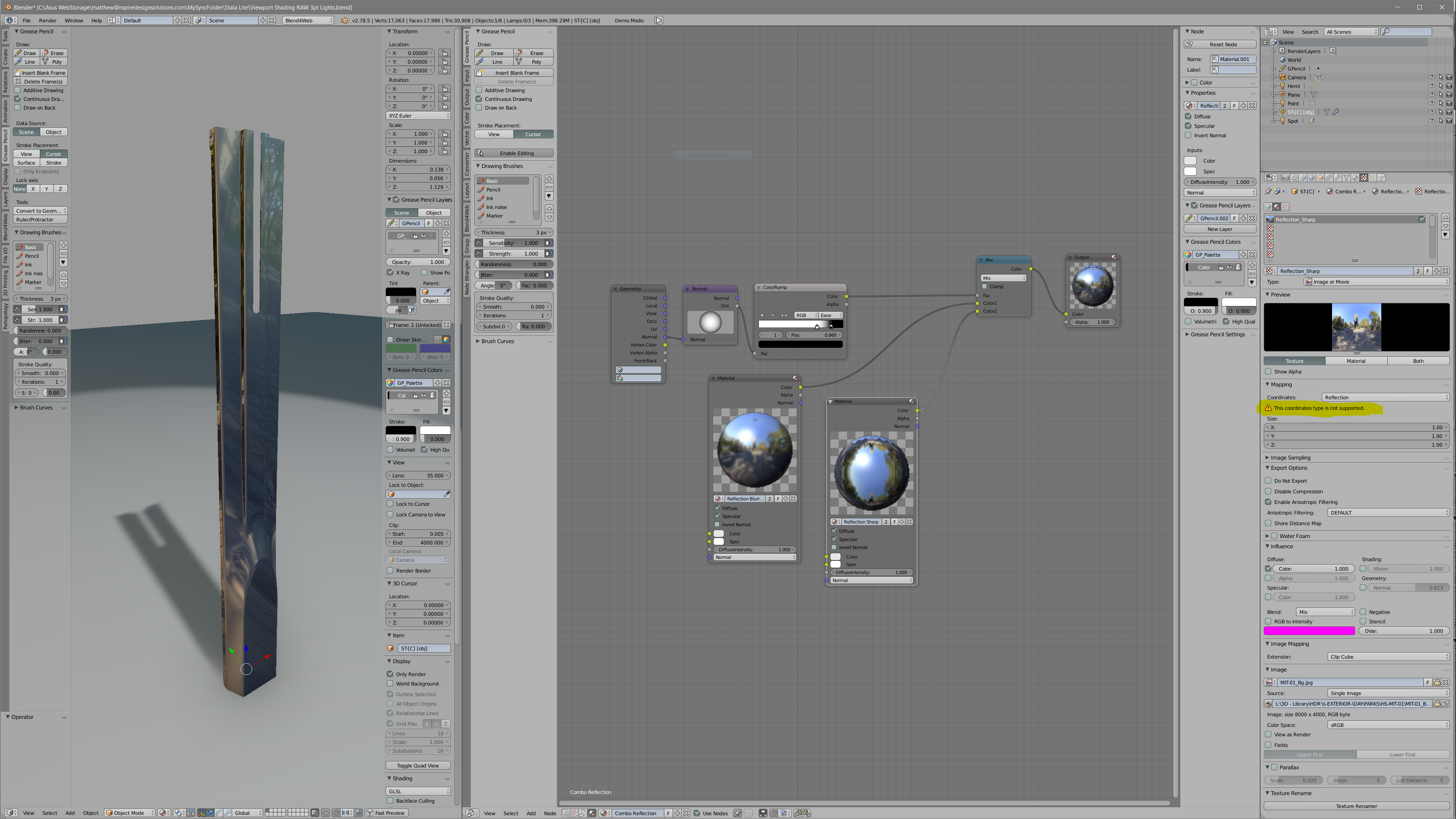Add "Reflection" as supported Mapping Type
28 June 2017 09:58
I have been playing with different techniques that generate PBR (Physically Based Rendering) viewport materials. I came across a good tutorial here:
https://www.youtube.com/watch?v=Jb_Xf4SWljs
-which was not targeted specifically at blend4web; though I like how this type of material gives me a lot of control of a realistic layered material using very few inputs and nodes.
I attached a screenshot of my results using this method; and it seems to me that the only thing that keeps this from working with Blend4web is the setting on the Image Mapping that is set to "Reflection". The thing that is really clever about this setup is it uses two image (one sharp & one blurry); and uses a color map to replicate a Fresnel effect between the two images. This results in a very realistic setup that has different characteristics at different viewing angels; making it look quite impressive with so little inputs.
![]()
If this was supported; it would be a complete game changer. I could generate 2 images to use as reflection maps that blend based on the manual Fresnel setup as shown in the tutorial. I could easily see adding a bump texture as a finishing touch using nodes on top of what I already did. This could work for Metals, Plastics, and many other materials that have reflective properties.
Is there any possibility this could be supported? and if not; do you have any suggestions that would give similar control with comparable simplicity?
Thanks
https://www.youtube.com/watch?v=Jb_Xf4SWljs
-which was not targeted specifically at blend4web; though I like how this type of material gives me a lot of control of a realistic layered material using very few inputs and nodes.
I attached a screenshot of my results using this method; and it seems to me that the only thing that keeps this from working with Blend4web is the setting on the Image Mapping that is set to "Reflection". The thing that is really clever about this setup is it uses two image (one sharp & one blurry); and uses a color map to replicate a Fresnel effect between the two images. This results in a very realistic setup that has different characteristics at different viewing angels; making it look quite impressive with so little inputs.

If this was supported; it would be a complete game changer. I could generate 2 images to use as reflection maps that blend based on the manual Fresnel setup as shown in the tutorial. I could easily see adding a bump texture as a finishing touch using nodes on top of what I already did. This could work for Metals, Plastics, and many other materials that have reflective properties.
Is there any possibility this could be supported? and if not; do you have any suggestions that would give similar control with comparable simplicity?
Thanks
28 June 2017 11:00
Blend4web is the setting on the Image Mapping that is set to "Reflection". TReflection type is supported but only for simple material< not for using in node sistem.
f this was supported; it would be a complete game changer. I could generate 2 images to use as reflection maps that blend based on the manual Fresnel setup as shown in the tutorial. I could easily see adding a bump texture as a finishing touch using nodes on top of what I already did. This could work for Metals, Plastics, and many other materials that have reflective properties.For that need we uses another setup, it's more complex but works the same. I prepeared an example for you.
reflection.blend - here you can find two versions: one is your yours and another is version that we usualy use in our materials.
Blend4web and that kind of thing.
28 June 2017 11:08
Thanks Mikhail, I took a look at it and it does look to still be fairly straightforward. (Compared to most other material examples I've seen so far.) I want to make sure I'm understanding correctly; that the four images in your setup are environment images used as reflection, and there is actually no "World Environment Texture" in the scene . . .
-EDIT- I just noticed that top an bottom nodes were Material Nodes; and the two in-between are Textures. So I'm still just checking that my assumption is correct that the reflections are only driven by those two images; and not the outside world environment . . . .
-EDIT- I just noticed that top an bottom nodes were Material Nodes; and the two in-between are Textures. So I'm still just checking that my assumption is correct that the reflections are only driven by those two images; and not the outside world environment . . . .
28 June 2017 11:34
-EDIT- I just noticed that top an bottom nodes were Material Nodes; and the two in-between are Textures. So I'm still just checking that my assumption is correct that the reflections are only driven by those two images; and not the outside world environment . . . .Yes, exactly! Materials nodes used just to get different specular for each image.
Blend4web and that kind of thing.
28 June 2017 11:37
Brilliant! Thank You for the example. You just made my life so much easier! I now see a workflow that is simple & straightforward; that will work for most of the materials I need to create. (Though I may be back to ask for help with clear Acrylic . . . . Though I will spend some time playing first)
28 June 2017 11:41

